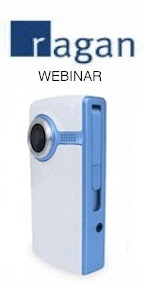This post was originally published on Larry Kless’ Weblog: How to Produce Flip Videos that Inform, Engage and Entertain Your Employees – Update from Ragan Communications Webinar, May 14, 2010 on May 22, 2010.

I was a featured speaker recently on a webinar hosted by Ragan Communications on, “How to produce Flip videos that inform, engage and entertain your employees.” I wore my day job hat for this event, as a multimedia professional for Kaiser Permanente, and was joined by my colleague Elizabeth Schainbaum, a staff writer in our Corporate Communications department. We discussed how we’re using Flip and Kodak pocket video cameras to capture important employee news to post on our company’s Intranet portal. Liz shared her experience as a writer turned video producer, who really hadn’t used a Flip camera before but was charged to produce a short video, rather than write a story about how one of our medical team’s from South Sacramento were conducting a trauma response training at our Sidney Garfield Health Care Innovation Center. The medical team ran a series of simulations on how to respond to gun shot wound victims and other severe injuries to prepare for the opening of Kaiser Permanente’s first Level II trauma center. Liz’s manager thought it would be a great opportunity to use video to tell the story.In preparation for the video shoot, Liz asked me for a few pointers on how to capture the story using a Flip camera. Her boss handed her a Flip without any instructions and only about a day or so to prepare. I had previously led a Flip 101 training session for some of her colleagues in Media Relations and Corporate Communications, who also were given Flip cameras as part of KP’s growing use of social media within internal and external communications.
Liz and I had a brief hallway conversation, and I shared a few important tips that I thought would help her produce a better end product – such as, use a tripod or hold the camera steady, interview a few people, make sure they introduce themselves and keep their answers concise, also have them include your question in their answer for context, try to have an interesting background, stay close since the microphone is built in, shoot some B-roll so you can edit in some cut-aways, just to name a few.After her video shoot, Liz worked with one of our Sr. Web Developers to both edit the video and post it to our Intranet website.
The topics we covered included:
- How to frame an interview to give your speaker enough head room
- When to use a tripod and why you should avoid zooming
- How to select the best background for your interview
- Tricks to make sure your video is always sharp and in focus
Lighting:
- What kind of lighting conditions you need for good picture quality
- How to avoid producing grainy video
- Ways to light your subject, without buying expensive equipment
Audio:
- How to avoid distracting background noise
- Why you need to stay close to your interview subject
- When to use an external microphone
Editing:
- Why shorter is always better
- Types of free software you can use to create your video vignettes—and optional equipment you can buy if you want to kick it up a notch
- A step-by-step process to edit your Flip video, including transferring the video, creating a timeline and uploading it to your intranet or YouTube
How to produce stellar employee videos:
- What types of stories are best told with a Flip camera
- How to produce videos that your audience will want to watch—over and over again
- Why clips produced on a Flip can be more engaging that polished, professional videos
We were also joined by CEO Mark Ragan during the Q&A, who shared some tips of his own on how you can use a Flip camera at events to record simple “man (or woman) on the street” interviews. At a recent conference in London, he shot an number interviews with attendees ad asked them all the same question, “What British communicators hate about jargon?”. He was able to get a range of spontaneous and often humorous answers. He also recorded a brief introduction of himself to give it some context, by handing the camera to the last person he interviewed, then edited it all together in Windows Movie Maker on the plane ride home.
- When you’re shooting your video don’t forget to get a variety of shots as good B-roll.
- Anticipate any action, take charge and remove any obstructions that are in your way, rehearse your interviewees and do a couple takes.
- Don’t be afraid to ask them to start over if you need a shorter take or if they say too many “Umms”.
- If you’re using a Flip, try to use a back up audio recorder that has an external microphone. There’s a slide in the presentation with a few makes and model numbers you can try, or if you have more than one Flip, set one closer to your subject and splice the audio together when you’re editing.
- What’s important though, is to have a compelling story that can be told in 90 seconds or less, good audio and lighting, and a steady camera. That will help not only hold your audiences attention, but also as the title of the webinar says, inform, engage and even entertain them.

